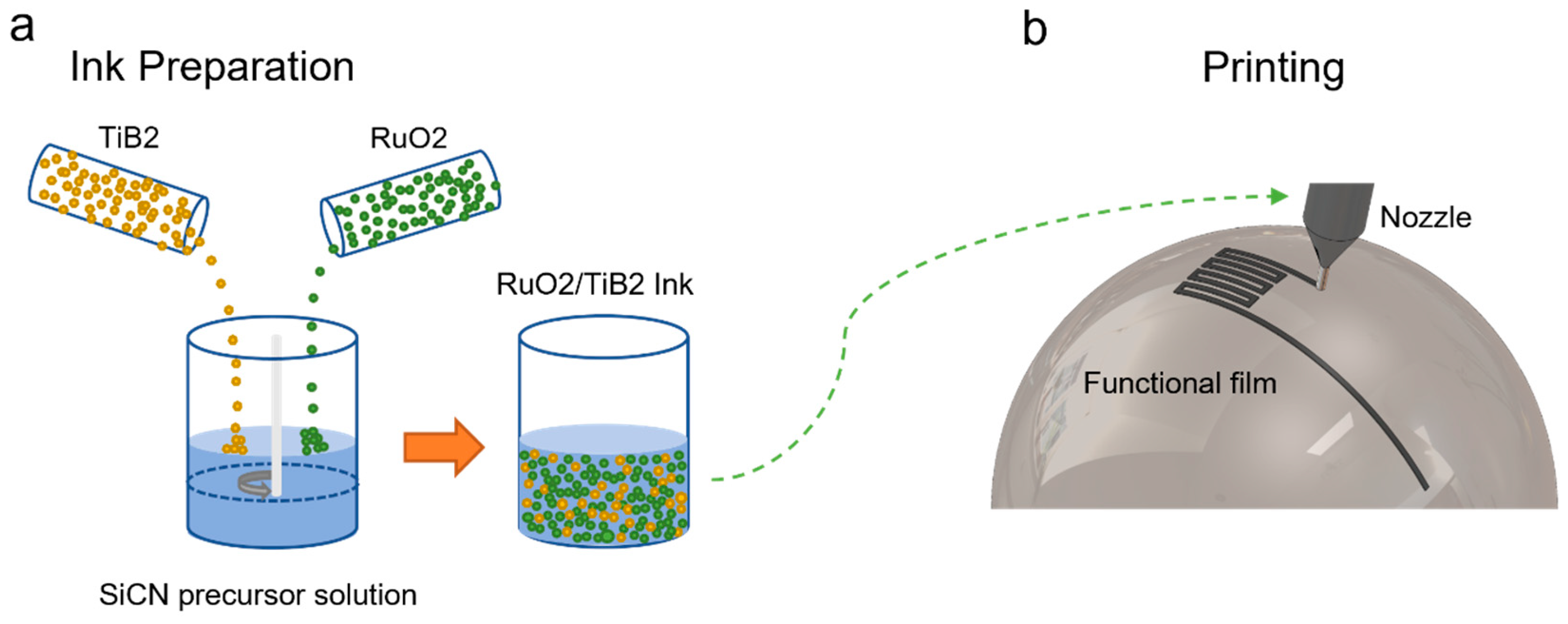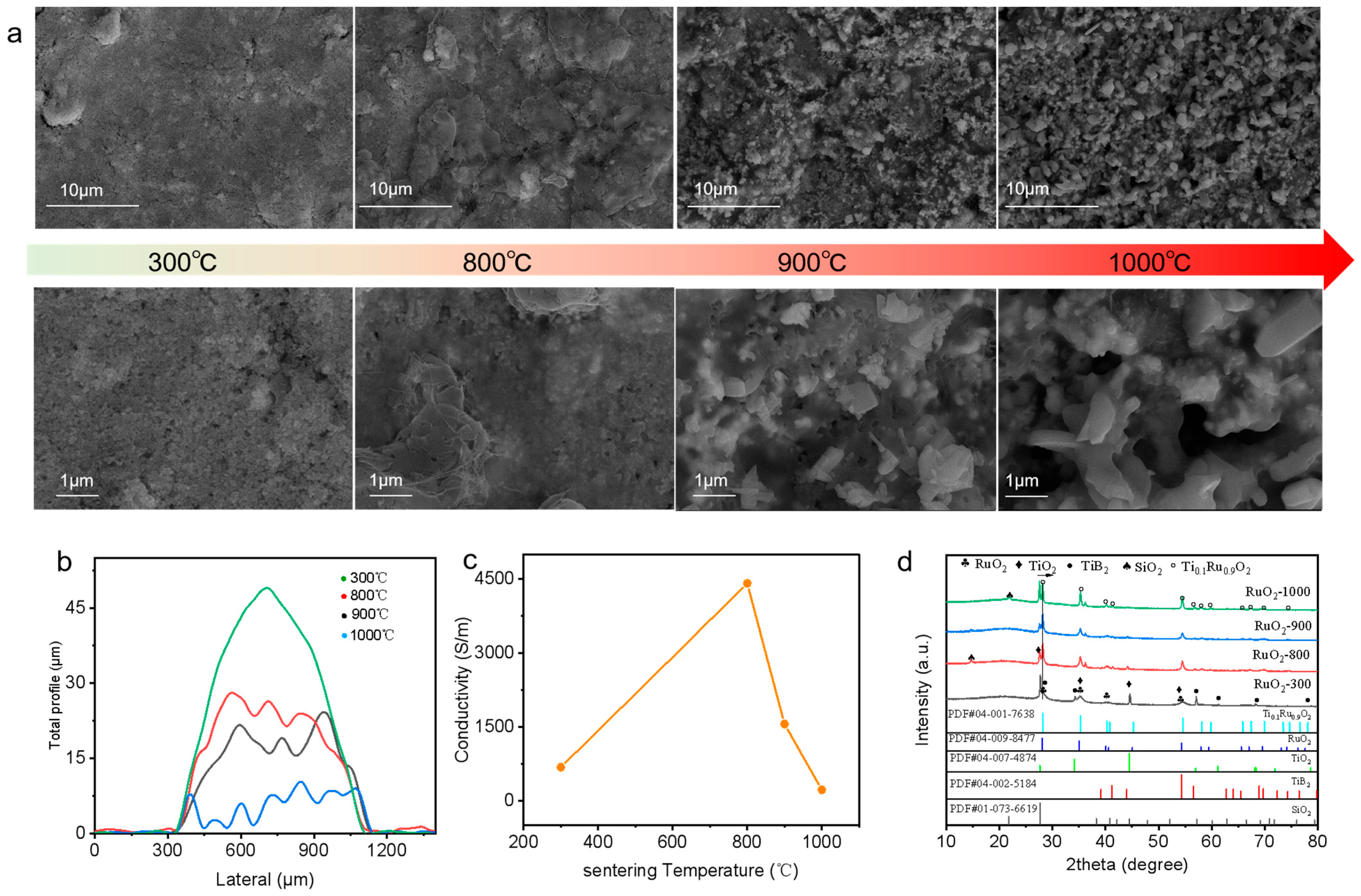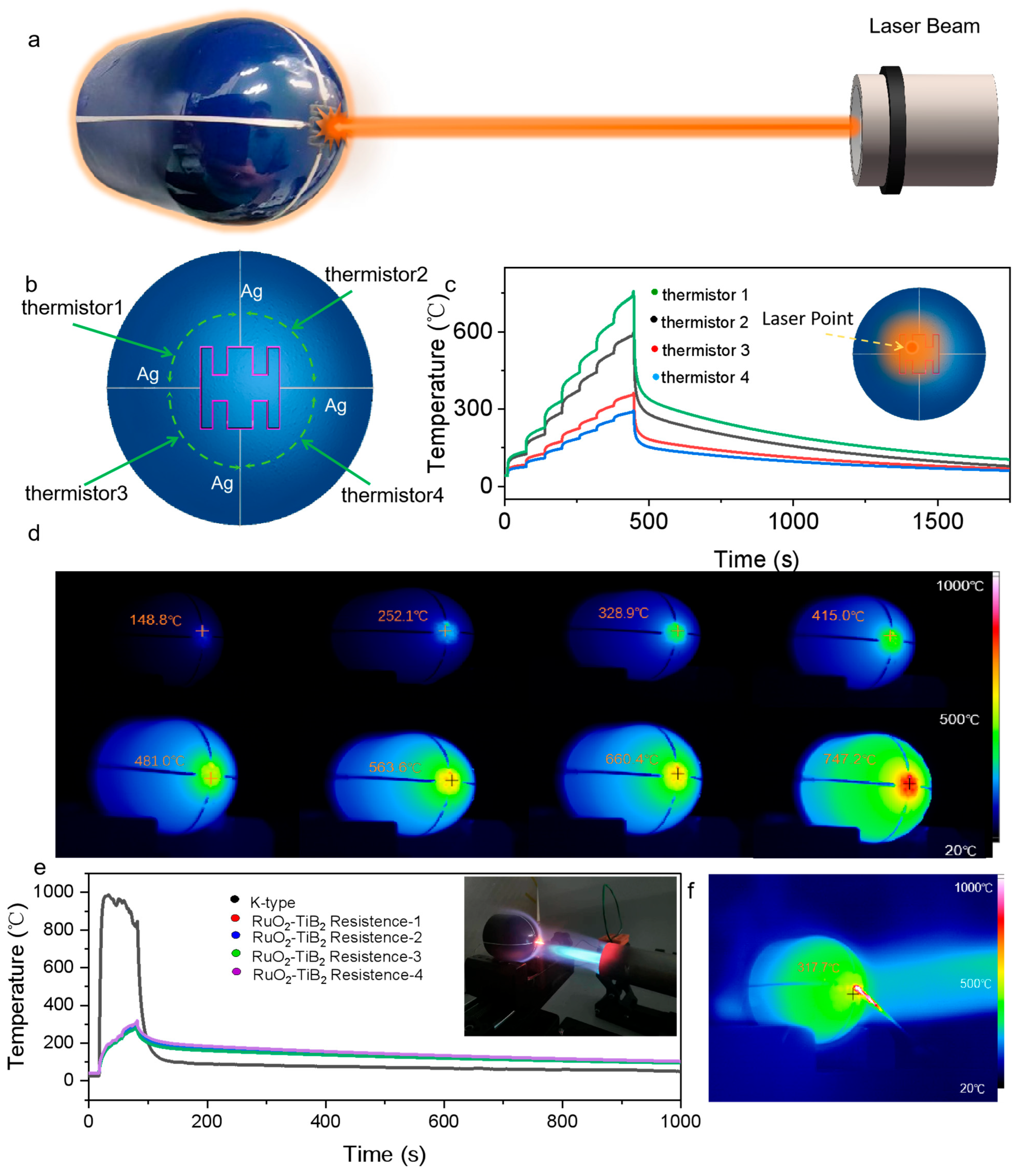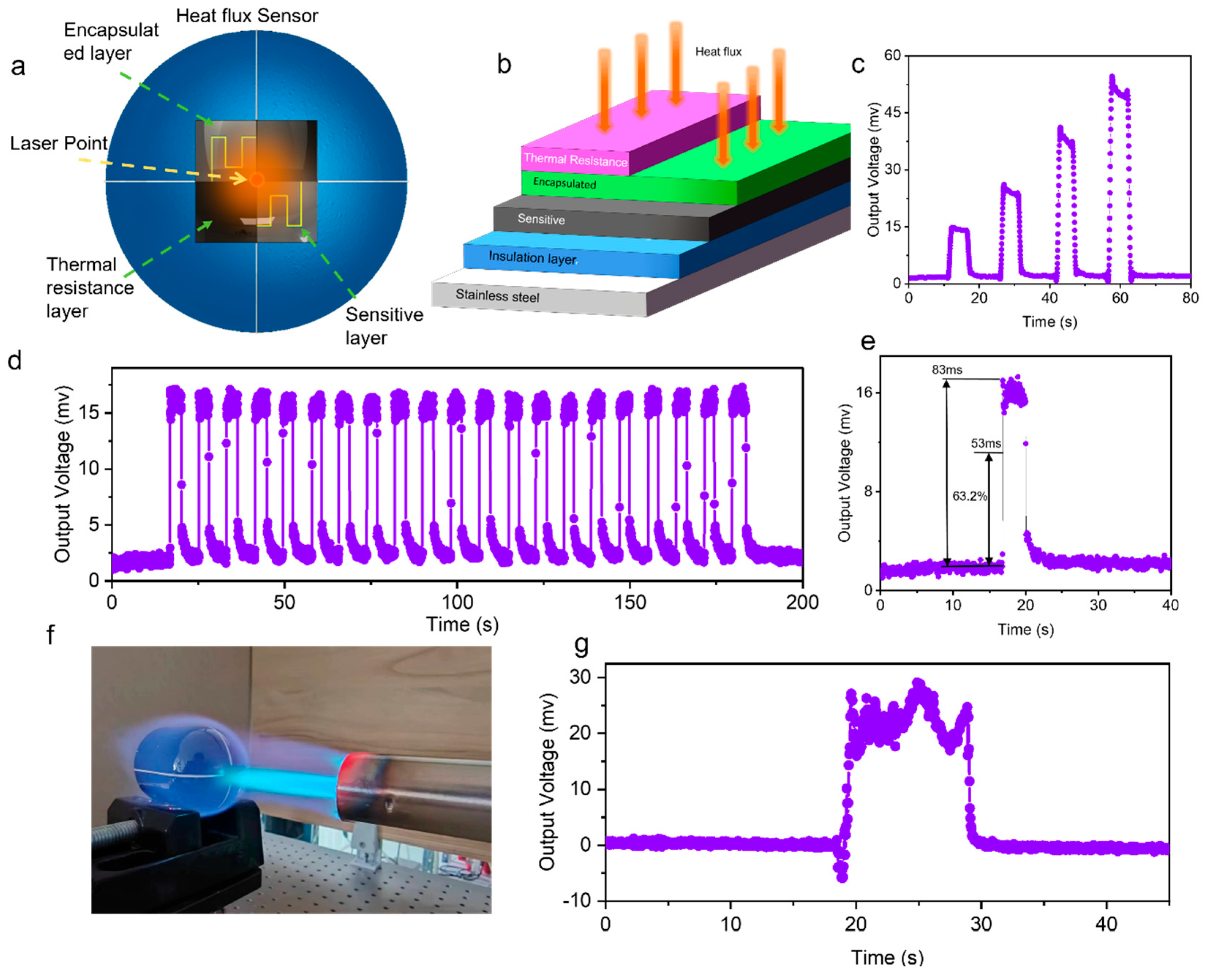Direct Ink Writing of SiCN/RuO2/TiB2 Composite Ceramic Ink for High-Temperature Thin-Film Sensors
Abstract
:1. Introduction
2. Materials and Methods
2.1. Materials
2.2. Fabrication Method
2.3. Characterization Methods
2.4. Testing Methods
3. Results
3.1. Sintering and Characteristics of the Conformal High-Temperature Sensitive Layer
3.2. Testing the Thermistor Performance of SiCN/RuO2/TiB2 Composite Ink Film
3.3. Application Verification of the SiCN/RuO2/TiB2 Composite Ink Conformal Thin-Film Thermistor Array
3.4. Application Test of the Conformal Film Heat Flux Sensor
4. Conclusions
Supplementary Materials
Author Contributions
Funding
Institutional Review Board Statement
Informed Consent Statement
Data Availability Statement
Acknowledgments
Conflicts of Interest
References
- Yang, S.; Li, H.; Lin, X.; Yao, J.; Yang, Z.; Zhang, C.; Wang, H.; Ding, G. Effect of Al2O3/Al bilayer protective coatings on the high-temperature stability of PdCr thin film strain gages. J. Alloys Compd. 2018, 759, 1–7. [Google Scholar] [CrossRef]
- Everton, S.K.; Hirsch, M.; Stravroulakis, P.; Leach, R.K.; Clare, A.T. Review of in-situ process monitoring and in-situ metrology for metal additive manufacturing. Mater. Des. 2016, 95, 431–445. [Google Scholar] [CrossRef]
- Mevissen, F.; Meo, M. A review of NDT/structural health monitoring techniques for hot gas components in gas turbines. Sensors 2019, 19, 711. [Google Scholar] [CrossRef] [PubMed]
- Wu, Y.; Zhang, H.; Zuo, L. Thermoelectric energy harvesting for the gas turbine sensing and monitoring system. Energy Convers. Manag. 2018, 157, 215–223. [Google Scholar] [CrossRef]
- Guangsheng, Z.; Chunsheng, N.; Zhanwei, C.; Ye, Y. Research progress of aerodynamic thermal environment test and measurement technology. J. Exp. Fluid Mech. 2019, 33, 1–10. [Google Scholar]
- Kandula, M.; Reinarts, T. Corrections for convective heat flux gauges subjected to a surface temperature discontinuity. In Proceedings of the 8th AIAA/ASME Joint Thermophysics and Heat Transfer Conference, St Louis, MO, USA, 24–27 June 2002; p. 3087. [Google Scholar]
- Bhatt, H.D.; Vedula, R.; Desu, S.B.; Fralick, G.C. Thin film TiC/TaC thermocouples. Thin Solid Film. 1999, 342, 214–220. [Google Scholar] [CrossRef]
- Fralick, G.; Wrbanek, J.; Blaha, C. Thin film heat flux sensor of improved design. In Proceedings of the 48th International Instrumentation Symposium, San Diego, CA, USA, 5–9 May 2002. [Google Scholar]
- Lei, J.-F.; Martin, L.C.; Will, H.A. Advances in Thin Film Sensor Technologies for Engine Applications; American Society of Mechanical Engineers: Richmond, VA, USA, 1997; Volume 78712. [Google Scholar]
- Martin, L.C.; Wrbanek, J.D.; Fralick, G.C. Thin film sensors for surface measurements [in aerospace simulation facilities]. In Proceedings of the ICIASF 2001 Record, 19th International Congress on Instrumentation in Aerospace Simulation Facilities (Cat. No. 01CH37215), IEEE, Cleveland, OH, USA, 27–30 August 2001; pp. 196–203. [Google Scholar]
- Xu, L.; Li, L.; Tang, L.; Zeng, Y.; Chen, G.; Shao, C.; Wu, C.; He, G.; Chen, Q.; Fang, G. Rapid Printing of High-Temperature Polymer-Derived Ceramic Composite Thin-Film Thermistor with Laser Pyrolysis. ACS Appl. Mater. Interfaces 2023, 15, 9996–10005. [Google Scholar] [CrossRef] [PubMed]
- Xu, L.; Zhou, X.; Zhao, F.; Fu, Y.; Tang, L.; Zeng, Y.; Chen, G.; Wu, C.; Wang, L.; Chen, Q. Rapid laser fabrication of indium tin oxide and polymer-derived ceramic composite thin films for high-temperature sensors. J. Colloid Interface Sci. 2024, 658, 913–922. [Google Scholar] [CrossRef] [PubMed]
- Rich, S.I.; Jiang, Z.; Fukuda, K.; Someya, T. Well-rounded devices: The fabrication of electronics on curved surfaces—A review. Mater. Horiz. 2021, 8, 1926–1958. [Google Scholar] [CrossRef]
- Tiggelaar, R.M.; Sanders, R.G.; Groenland, A.; Gardeniers, J.G. Stability of thin platinum films implemented in high-temperature microdevices. Sens. Actuators A Phys. 2009, 152, 39–47. [Google Scholar] [CrossRef]
- Liu, H.; Mao, X.; Yang, Z.; Cui, J.; Jiang, S.; Zhang, W. High temperature static and dynamic strain response of PdCr thin film strain gauge prepared on Ni-based superalloy. Sens. Actuators A Phys. 2019, 298, 111571. [Google Scholar] [CrossRef]
- Zhao, X.; Liang, X.; Jiang, S.; Zhang, W.; Jiang, H. Microstructure evolution and thermoelectric property of Pt-PtRh thin film thermocouples. Crystals 2017, 7, 96. [Google Scholar] [CrossRef]
- Li, C.; Liu, X.-Z.; Peng, B.; Shu, L.; Li, Y.-R. AlN-based surface acoustic wave resonators on platinum bottom electrodes for high-temperature sensing applications. Rare Met. 2016, 35, 408–411. [Google Scholar] [CrossRef]
- Hu, L.-H.; Fan, J.-H. Surface mechanical and electrochemical properties of zirconium oxide embedded silicon carbonitride ceramic composite film by polysilazane preceramic precursor. J. Alloys Compd. 2022, 922, 166290. [Google Scholar] [CrossRef]
- Xu, L.; Cui, Z.; Li, L.; He, Y.; Wu, C.; Chen, G.; Li, X.; He, G.; Hai, Z.; Chen, Q. In situ laser fabrication of polymer-derived ceramic composite thin-film sensors for harsh environments. ACS Appl. Mater. Interfaces 2022, 14, 12652–12661. [Google Scholar] [CrossRef] [PubMed]
- Dyer, S.; Gregory, O.; Amons, P.; Slot, A.B. Preparation and piezoresistive properties of reactively sputtered indium tin oxide thin films. Thin Solid Film. 1996, 288, 279–286. [Google Scholar] [CrossRef]
- Gregory, O.J.; Chen, X.; Crisman, E.E. Strain and temperature effects in indium–tin-oxide sensors. Thin Solid Film. 2010, 518, 5622–5625. [Google Scholar] [CrossRef]
- Oh, S.H.; Park, C.G.; Park, C.P. Thermal stability of RuO2/Ru bilayer thin film in oxygen atmosphere. Thin Solid Film. 2000, 359, 118–123. [Google Scholar] [CrossRef]
- Hai, Z.; Guo, M.; Xu, L.; Su, Z.; Wang, Y.; He, Y.; Zhao, Y.; Sun, D. Printable Silicate and RuO2 Composite with Wide-Range Linear PTC for High-Temperature Sensors. Ceram. Int. 2024, 50, 30776–30784. [Google Scholar] [CrossRef]
- Jelenkovic, E.V.; Tong, K.Y.; Cheung, W.Y.; Wong, S.P. RuO2–SiO2 composite thin films with wide resistivity range. Microelectron. Eng. 2004, 71, 237–241. [Google Scholar] [CrossRef]
- Eckel, Z.C.; Zhou, C.; Martin, J.H.; Jacobsen, A.J.; Carter, W.B.; Schaedler, T.A. Additive manufacturing of polymer-derived ceramics. Science 2016, 351, 58–62. [Google Scholar] [CrossRef]
- Chen, Y. Structure and Properties of Polymer-Derived SiBCN Ceramics. Ph.D. Thesis, University of Central Florida, Orlando, FL, USA, 2012. [Google Scholar]
- Colombo, P.; Mera, G.; Riedel, R.; Soraru, G.D. Polymer-derived ceramics: 40 years of research and innovation in advanced ceramics. J. Am. Ceram. Soc. 2010, 93, 1805–1837. [Google Scholar] [CrossRef]
- Sarkar, S.; Gan, Z.; An, L.; Zhai, L. Structural evolution of polymer-derived amorphous SiBCN ceramics at high temperature. J. Phys. Chem. C 2011, 115, 24993–25000. [Google Scholar] [CrossRef]
- Wang, Y.; An, L.; Fan, Y.; Zhang, L.; Burton, S.; Gan, Z. Oxidation of polymer-derived SiAlCN ceramics. J. Am. Ceram. Soc. 2005, 88, 3075–3080. [Google Scholar] [CrossRef]
- Lee, D.-H.; Park, K.-H.; Hong, L.-Y.; Kim, D.-P. SiCN ceramic patterns fabricated by soft lithography techniques. Sens. Actuators A Phys. 2007, 135, 895–901. [Google Scholar] [CrossRef]
- Liew, L.-A.; Liu, Y.; Luo, R.; Cross, T.; An, L.; Bright, V.M.; Dunn, M.L.; Daily, J.W.; Raj, R. Fabrication of SiCN MEMS by photopolymerization of pre-ceramic polymer. Sens. Actuators A Phys. 2002, 95, 120–134. [Google Scholar] [CrossRef]
- Barroso, G.; Li, Q.; Bordia, R.K.; Motz, G. Polymeric and ceramic silicon-based coatings—A review. J. Mater. Chem. A 2019, 7, 1936–1963. [Google Scholar] [CrossRef]
- Günthner, M.; Wang, K.; Bordia, R.K.; Motz, G. Conversion behaviour and resulting mechanical properties of polysilazane-based coatings. J. Eur. Ceram. Soc. 2012, 32, 1883–1892. [Google Scholar] [CrossRef]
- Mei, X.; Chen, Q.; Wang, S.; Wang, W.; Wu, D.; Sun, D. The microscale Weissenberg effect for high-viscosity solution pumping at the picoliter level. Nanoscale 2018, 10, 7127–7137. [Google Scholar] [CrossRef]
- Ni, D.; Cheng, Y.; Zhang, J.; Liu, J.-X.; Zou, J.; Chen, B.; Wu, H.; Li, H.; Dong, S.; Han, J. Advances in ultra-high temperature ceramics, composites, and coatings. J. Adv. Ceram. 2022, 11, 1–56. [Google Scholar] [CrossRef]
- Rahman, M.T.; Moser, R.; Zbib, H.M.; Ramana, C.; Panat, R. 3D printed high performance strain sensors for high temperature applications. J. Appl. Phys. 2018, 123, 024501. [Google Scholar] [CrossRef]
- Fricke, S.; Friedberger, A.; Seidel, H.; Schmid, U. A robust pressure sensor for harsh environmental applications. Sens. Actuators A Phys. 2012, 184, 16–21. [Google Scholar] [CrossRef]
- Sahul, R.; Tasovski, V.; Sudarshan, T. Ruthenium oxide cryogenic temperature sensors. Sens. Actuators A Phys. 2006, 125, 358–362. [Google Scholar] [CrossRef]
- Paquez, X.; Amiard, G.; De Combarieu, G.; Boissière, C.; Grosso, D. Resistant RuO2/SiO2 absorbing sol–gel coatings for solar energy conversion at high temperature. Chem. Mater. 2015, 27, 2711–2717. [Google Scholar] [CrossRef]
- Piccini, E.; Guo, S.; Jones, T. The development of a new direct-heat-flux gauge for heat-transfer facilities. Meas. Sci. Technol. 2000, 11, 342. [Google Scholar] [CrossRef]
- Zribi, A.; Barthès, M.; Bégot, S.; Lanzetta, F.; Rauch, J.Y.; Moutarlier, V. Design, fabrication and characterization of thin film resistances for heat flux sensing application. Sens. Actuators A Phys. 2016, 245, 26–39. [Google Scholar] [CrossRef]






Disclaimer/Publisher’s Note: The statements, opinions and data contained in all publications are solely those of the individual author(s) and contributor(s) and not of MDPI and/or the editor(s). MDPI and/or the editor(s) disclaim responsibility for any injury to people or property resulting from any ideas, methods, instructions or products referred to in the content. |
© 2024 by the authors. Licensee MDPI, Basel, Switzerland. This article is an open access article distributed under the terms and conditions of the Creative Commons Attribution (CC BY) license (https://creativecommons.org/licenses/by/4.0/).
Share and Cite
Wang, Y.; Xu, L.; Zhou, X.; Zhao, F.; Liu, J.; Wang, S.; Sun, D.; Chen, Q. Direct Ink Writing of SiCN/RuO2/TiB2 Composite Ceramic Ink for High-Temperature Thin-Film Sensors. Materials 2024, 17, 3792. https://doi.org/10.3390/ma17153792
Wang Y, Xu L, Zhou X, Zhao F, Liu J, Wang S, Sun D, Chen Q. Direct Ink Writing of SiCN/RuO2/TiB2 Composite Ceramic Ink for High-Temperature Thin-Film Sensors. Materials. 2024; 17(15):3792. https://doi.org/10.3390/ma17153792
Chicago/Turabian StyleWang, Yusen, Lida Xu, Xiong Zhou, Fuxin Zhao, Jun Liu, Siqi Wang, Daoheng Sun, and Qinnan Chen. 2024. "Direct Ink Writing of SiCN/RuO2/TiB2 Composite Ceramic Ink for High-Temperature Thin-Film Sensors" Materials 17, no. 15: 3792. https://doi.org/10.3390/ma17153792



